Research Projects
Below is a list of current projects by faculty in UConn's Department of Chmeistry broken down by research divisions. Please note that not all research projects and groups are available each summer.
Analytical Chemistry
Building Functional Nanodevices with Porous Nanocapsules
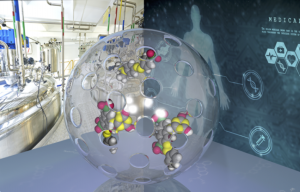 Our research group designs functional nanomaterials and devices with new and superior properties to address global challenges in energy-related technologies, sensing, and medical imaging and treatment. We have developed a directed assembly method for the synthesis of vesicle-templated nanocapsules. These nanocapsules offer a unique combination of properties enabled by robust shells with the single-nanometer thickness containing programmed uniform pores capable of fast and selective mass transfer. Vesicle-templated nanocapsules emerged as a versatile platform for creating functional devices, such as nanoreactors, nanosensors, and containers for drug delivery.
Our research group designs functional nanomaterials and devices with new and superior properties to address global challenges in energy-related technologies, sensing, and medical imaging and treatment. We have developed a directed assembly method for the synthesis of vesicle-templated nanocapsules. These nanocapsules offer a unique combination of properties enabled by robust shells with the single-nanometer thickness containing programmed uniform pores capable of fast and selective mass transfer. Vesicle-templated nanocapsules emerged as a versatile platform for creating functional devices, such as nanoreactors, nanosensors, and containers for drug delivery.
The REU student will learn an array of synthetic and analytical techniques ranging from the synthesis of polymer nanocapsules, using self-assembled structures to direct organic synthesis, characterizing nanoscale objects with light scattering and electron microscopy, and evaluating the performance of newly created nanodevices with spectroscopic and chromatographic methods. Having mastered the synthesis of nanocapsules, the REU student will use the capsules to build nanodevices aiming at one of the following applications: nanoreactors with encapsulated homogeneous or enzymatic catalysts, highly selective nanoprobes, containers for the delivery of drugs or imaging agents, or cell-mimicking devices capable of through-shell communication.
Cancer Biomarker Detection by Immunoarrays
PI: James F. Rusling
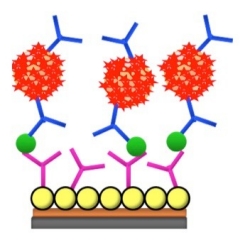 One focus of our research is to design immunoarrays for proteins based on nanomaterials. This project is in collaboration with materials scientist Profs. Papadimitrakopoulos at UConn and the NIH cancer biologists in Bethesda, MD, and has early cancer detection and monitoring as its goal. In this project, the REU student will utilize newly developed array fabrication and coating techniques to develop and evaluate electrochemical immunoarrays based on gold nanoparticle electrodes in microfluidic devices. Arrays will utilize captured antibodies spotted on multi-electrode chips to detect major protein biomarkers for oral and other cancers.
One focus of our research is to design immunoarrays for proteins based on nanomaterials. This project is in collaboration with materials scientist Profs. Papadimitrakopoulos at UConn and the NIH cancer biologists in Bethesda, MD, and has early cancer detection and monitoring as its goal. In this project, the REU student will utilize newly developed array fabrication and coating techniques to develop and evaluate electrochemical immunoarrays based on gold nanoparticle electrodes in microfluidic devices. Arrays will utilize captured antibodies spotted on multi-electrode chips to detect major protein biomarkers for oral and other cancers.
The student will develop analytical protocols for these analyses in serum samples, and attempt to improve sensitivity, detection limit and reproducibility compared to our existing arrays. The student will learn state-of-the-art biomedical sensor preparation technology utilizing nanoparticles and ink-jet biomolecule spotting. The student will also gain experience in electrochemical, AFM and spectroscopic analyses to monitor array fabrication, and the use amperometry for biomarker detection with the microfluidic arrays.
Mass Spectrometry to Investigate Micro-Scale Preparation of Peptide Samples
PI: Xudong Yao
Mass spectrometry is used as a fast and sensitive tool to study peptides. Mass spectrometry analyzes charge-to-mass ratios of peptide ions in gas phase. A mass spectrum plots the intensities of ions against their charge-to-mass ratios. These ratios can be used to determine chemical structures of peptides, while the intensities give relative quantitation of the ions. Sample preparation of peptides is a key step for successful mass spectrometric analysis, and it is often done at a micro-scale. In REU summer projects, students will work on different sample manipulations of peptides such as chemical modification of peptide mixtures and use mass spectrometry to study the efficiency of various micro-scale procedures for peptide sample preparation.
The REU project will specifically investigate analytical challenges in mass spectrometric analysis of phosphopeptides. Phosphopeptides are fragments of phosphoproteins that are important regulators for cellular signaling. Analysis of protein phosphorylation is important to understand and treat various human diseases and to manipulate the fate of stem cells for therapeutic and regenerative applications. The REU researcher will study ß-elimination and Michael addition reactions of phosphopeptides. Objectives of the project are to minimize side reactions and maximize the efficiency of the sample preparation workflow that will be examined by high performance liquid chromatography and tandem mass spectrometry.
Synthesis and Application of Metal and Semiconductor Nanoparticles
PI: Jing Zhao
 Metal and semiconductor particles at the nanoscale exhibit unique optical properties. One example is size-dependent photoluminescence of semiconductor nanocrystals, which are also known as quantum dots (QDs). QDs have been incorporated into commercial products such as Q-LED TVs. To achieve the desired properties of the nanomaterials, it is critical to control their size and composition. In our lab, we explore new synthetic methods to obtain nanomaterials of varying compositions with uniform morphology. The REU students will gain knowledge in nanomaterials and hands-on experience on nano-synthesis and optical spectroscopy. The student will also have opportunities to apply the nanomaterials in photocatalysis or sensing.
Metal and semiconductor particles at the nanoscale exhibit unique optical properties. One example is size-dependent photoluminescence of semiconductor nanocrystals, which are also known as quantum dots (QDs). QDs have been incorporated into commercial products such as Q-LED TVs. To achieve the desired properties of the nanomaterials, it is critical to control their size and composition. In our lab, we explore new synthetic methods to obtain nanomaterials of varying compositions with uniform morphology. The REU students will gain knowledge in nanomaterials and hands-on experience on nano-synthesis and optical spectroscopy. The student will also have opportunities to apply the nanomaterials in photocatalysis or sensing.
Biological Chemistry
Mechanistic Inorganic Chemistry

We use synthetic chemistry, both organic and inorganic, as a tool to design and build new molecules for targeted applications. We are particularly interested in the social dilemmas of climate change and antibiotic resistance. Interestingly, both problems can be thought as examples of tragedies of the commons.
Our current research efforts are centered in two key areas:
1) Development of novel catalysts for the activation of small molecules (CO2, O2, H2O). We synthesize new catalysts and study their activity with a focus on kinetics and reaction mechanisms. We are one of the few groups in the world that use of heavy atom isotope effects to study reaction mechanisms.
2) Design and synthesis of compounds with medicinal properties that take advantage of the important role of metal ions in biological systems. Our approach involves synthesizing novel molecules and characterizing them with an arsenal of physical, chemical and spectroscopic data. In recent years, we have focused on the synthesis of peptides and peptidomimetics.
Synthesis and Study of DNA Damages
PI: Ashis K. Basu
We study chemicals and drugs that exert their biological effects through DNA damage. Some of the chemicals are environmental pollutants such as 1–nitropyrene. We also study ionizing radiation-induced DNA damages. The REU student will synthesize a specific DNA damage such as a DNA adduct of a nitroaromatic compound or induce an ionizing radiation damage into a designed oligo¬deoxy¬nucleotide. These DNA lesions can induce mutations which may represent the first step converting a normal cell into a cancer cell. Our goal is to correlate the type of mutation with three dimensional architectural effects induced in DNA. The modified DNA fragments will be used to study mutagenesis and DNA repair.
The project will introduce the REU student to a variety of organic synthesis and nucleic acid chemistry tools, chromatography, and structural characterization (NMR, UV-Vis, MS), and introduce the student to molecular biology and recombinant DNA techniques.
Synthesis and characterization of photoswitchable inhibitors of potassium channels
PI: Michael Kienzler
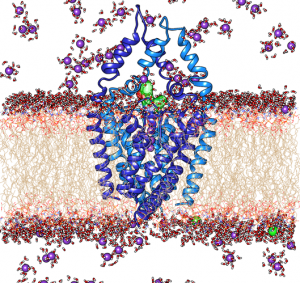
Potassium channels are essential proteins for maintaining excitable cells’ membrane potential, perhaps best known for their role in neuron action potential firing. New molecular tools are needed to interrogate the function of potassium channels with high spatiotemporal precision. Our lab is interested in synthesizing small, photoswitchable molecules that can be used to control protein function, and in this project in particular, potassium channel blockers that can be turned “on” and “off” with different wavelengths of light. To achieve this goal, our photoswitch of choice is azobenzene, which can isomerize between cis and trans forms by irradiating the molecule with different wavelengths of light in the Ultraviolet/visible range.
The REU student will synthesize a series of azobenzene-based photoswitchable inhibitors of potassium channels (2-5 steps), purifying (via column chromatography and HPLC) and characterizing (NMR, Mass Spec) their compounds as they go. The photochemical properties of the final compounds will also be determined (UV/vis spectroscopy, NMR).
Enzyme-assembled Nanocapsules for Targeted Drug Delivery
PI: Jessica Rouge
We seek to design, synthesize and characterize nanomaterials that can target specific cell types for the delivery of therapeutic nucleic acids and small molecule drugs.
Nanomaterials have revolutionized the way drugs can be delivered thanks to their small size and enhanced chemical stability. However the ability to direct them to specific cellular targets and to control the release of their therapeutic cargo has been a major obstacle in the field. Our lab seeks to develop new materials that can direct the localization of a nanomaterial to specific cell receptors through the use of DNA aptamers. Aptamers are DNA and RNA sequences that strongly bind specific cellular locations or proteins. We are also interested in controlling the release of the nanomaterials contents through interactions with specific enzymes (esterases). We work to synthesize new substrates that can direct enzymes to the surface of nanomaterials in order to facilitate the enzyme-mediated assembly of chemically modified aptamers to particle surfaces along with the degradation of the nanomaterials itself.
An undergraduate researcher will be exposed to a highly interdisciplinary lab environment, being trained by both a graduate student and the faculty member. The students will learn both chemical and biochemical techniques such as nanoparticle synthesis, automated DNA synthesis, HPLC, PCR, RNA transcription and other enzymatic reactions.
Mass Spectrometry to Investigate Micro-Scale Preparation of Peptide Samples
PI: Xudong Yao
Mass spectrometry is used as a fast and sensitive tool to study peptides. Mass spectrometry analyzes charge-to-mass ratios of peptide ions in gas phase. A mass spectrum plots the intensities of ions against their charge-to-mass ratios. These ratios can be used to determine chemical structures of peptides, while the intensities give relative quantitation of the ions. Sample preparation of peptides is a key step for successful mass spectrometric analysis, and it is often done at a micro-scale. In REU summer projects, students will work on different sample manipulations of peptides such as chemical modification of peptide mixtures and use mass spectrometry to study the efficiency of various micro-scale procedures for peptide sample preparation.
The REU project will specifically investigate analytical challenges in mass spectrometric analysis of phosphopeptides. Phosphopeptides are fragments of phosphoproteins that are important regulators for cellular signaling. Analysis of protein phosphorylation is important to understand and treat various human diseases and to manipulate the fate of stem cells for therapeutic and regenerative applications. The REU researcher will study ß-elimination and Michael addition reactions of phosphopeptides. Objectives of the project are to minimize side reactions and maximize the efficiency of the sample preparation workflow that will be examined by high performance liquid chromatography and tandem mass spectrometry.
Inorganic Chemistry and Materials
Mechanistic Inorganic Chemistry

We use synthetic chemistry, both organic and inorganic, as a tool to design and build new molecules for targeted applications. We are particularly interested in the social dilemmas of climate change and antibiotic resistance. Interestingly, both problems can be thought as examples of tragedies of the commons.
Our current research efforts are centered in two key areas:
1) Development of novel catalysts for the activation of small molecules (CO2, O2, H2O). We synthesize new catalysts and study their activity with a focus on kinetics and reaction mechanisms. We are one of the few groups in the world that use of heavy atom isotope effects to study reaction mechanisms.
2) Design and synthesis of compounds with medicinal properties that take advantage of the important role of metal ions in biological systems. Our approach involves synthesizing novel molecules and characterizing them with an arsenal of physical, chemical and spectroscopic data. In recent years, we have focused on the synthesis of peptides and peptidomimetics.
From the Kitchen to the Lab
We all know that microwave ovens can be used for heating food fast. An exciting area of study in the synthetic chemistry community is the use of microwaves for making molecules rapidly, easily and cleanly. Using microwave heating, it is possible to enhance the rate of chemical reactions significantly and to do chemistry that was otherwise not possible. Unlike the microwave at home, we use state-of-the-art scientific microwave systems that allow precise control of reaction conditions. One limitation at the moment is the scale-up of reactions to make multi-gram or kilo quantities of compounds. However, we are about to receive a microwave apparatus that is designed to overcome this hurdle. As an REU student, you would play an important role in using this apparatus over the summer and would have your own mini-project focused around the use of microwave heating for scaling-up reactions. You will be mentored by a graduate student in the group. The reactions will be performed in water as a solvent rather than organic solvents thus making the chemistry more environmentally friendly. As well as being exciting, the project will introduce you to a range of modern synthetic chemistry techniques as well as analysis methods.
Building Functional Nanodevices with Porous Nanocapsules
 Our research group designs functional nanomaterials and devices with new and superior properties to address global challenges in energy-related technologies, sensing, and medical imaging and treatment. We have developed a directed assembly method for the synthesis of vesicle-templated nanocapsules. These nanocapsules offer a unique combination of properties enabled by robust shells with the single-nanometer thickness containing programmed uniform pores capable of fast and selective mass transfer. Vesicle-templated nanocapsules emerged as a versatile platform for creating functional devices, such as nanoreactors, nanosensors, and containers for drug delivery.
Our research group designs functional nanomaterials and devices with new and superior properties to address global challenges in energy-related technologies, sensing, and medical imaging and treatment. We have developed a directed assembly method for the synthesis of vesicle-templated nanocapsules. These nanocapsules offer a unique combination of properties enabled by robust shells with the single-nanometer thickness containing programmed uniform pores capable of fast and selective mass transfer. Vesicle-templated nanocapsules emerged as a versatile platform for creating functional devices, such as nanoreactors, nanosensors, and containers for drug delivery.
The REU student will learn an array of synthetic and analytical techniques ranging from the synthesis of polymer nanocapsules, using self-assembled structures to direct organic synthesis, characterizing nanoscale objects with light scattering and electron microscopy, and evaluating the performance of newly created nanodevices with spectroscopic and chromatographic methods. Having mastered the synthesis of nanocapsules, the REU student will use the capsules to build nanodevices aiming at one of the following applications: nanoreactors with encapsulated homogeneous or enzymatic catalysts, highly selective nanoprobes, containers for the delivery of drugs or imaging agents, or cell-mimicking devices capable of through-shell communication.
Catalysts, Ceramics, Batteries, and Adsorbents
PI: Steven L. Suib

Departments of Chemistry, Chemical Engineering, and Materials Science and Engineering, and Institute of Materials Science.
Our NSF funded research program involves the preparation of aligned crystallites on solid surfaces that can be used as Catalysts, Ceramics, Batteries, and Adsorbents. Much of this research involves synthesis of novel metal oxide and sulfide materials that are densely packed but accessible to chemical reagents for distinct chemical and physical reactions.
Figure 1 shows a diagram of one of the synthetic processes that is used to make such oriented crystallites. These nano-sized materials are shown to be well aligned in the scanning electron micrograph shown above. The photograph on the right in Figure 1 is that of an uncoated (cream color) cordierite monolith like that in an auto exhaust system in cars and the coated (dark brown) honeycomb support with aligned crystallites. A major advantage of the alignment is that more accessible sites are available for whatever the specific application might be.
For example, the materials in Figure 1 are being studied as auto exhaust catalysts and have shown excellent activity and stability in the oxidation of CO and the reduction of NOx. the same types of oriented materials can enhance the capacity of battery materials, and increase the amount of adsorption for example of extracting harmful sulfur and nitrogen species from a variety of fuels. Many of these materials act as ceramic systems that are stable at very high (> 500oC) temperatures.
The type of research that would be done under an REU summer program would involve any aspect of synthesis, characterization, or applications of such oriented materials. Related goals of this research program involve use of green reagents, regeneration and sustainability of systems, and scale-up of materials and processes.
References.
Chen, S. Y.; Song, W.; Lin, H. J.; Wang, S.; Biswas, S.; Mollahosseini, M.; Kuo, C. H.; Gao, P. X.; Suib, S. L.; Manganese Oxide Nano-Array Based Monolithic Catalysts: Tunable Morphology and High Efficiency for CO Oxidation, ACS Appl. Mat. & Int., 2016, 8, 7834-7842.
Dutta, B.; Biswas, S.; Sharma, V.; Savage, N. O.; Alpay, S. P.; Suib, S. L., Mesoporous Manganese Oxide Catalyzed Aerobic Oxidative Coupling of Anilines to Aromatic Azo Compounds, Ang. Chem. Int. Ed., 2016, 55, 2171-2175.
Synthesis of molecules emitting chiral light
PI: Gaël Ung
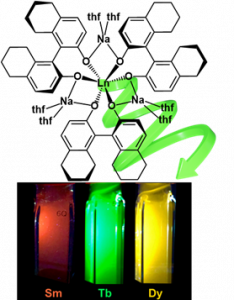
Circularly polarized luminescence (CPL) is the preferential emission of light with a certain circular polarization. Upon non-polarized light absorption, a chiral molecule reaches a preferential excited state which radiatively decays by emitting circularly polarized photons. CPL has emerged as a next-generation light source since the added chiral optical information presents unique opportunities to enhance optical displays, bio-imaging, and security f eatures for banknotes and identification documents. The REU student will synthesize chiral and enantiopure ligands, and study their coordination to lanthanides. The complexes obtained should exhibit CPL. Our laboratory is equipped with two rare CPL spectrometers, including the only NIR-CPL in the Americas. The REU student will be trained in a large variety of synthetic techniques (bench top, Schlenk, glove box), as well as spectroscopic characterizations (NMR, UV-vis, IR, EPR, CPL).
Organic Chemistry
Synthesis of Pyrrole-Modified Porphyrins
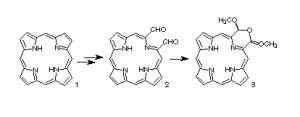
Photodynamic therapy (PDT) employs the combination of a photosensitizer, such as a porphyrin, and light to destroy diseased cells. For PDT to be most effective, the light that activates the drug must penetrate deep into tissue. However, while tissue is only transparent for red and infrared light, porphyrins cannot be activated using red light. Thus, our group has set out a program to modify synthetic porphyrins in a way that they can become photosensitizers which can be activated with red light. Although porphyrins are ubiquitous naturally occurring macrocycles, the regio-selective modification of them can be difficult. Hence, synthetic compounds are needed.
We modify a class sof symmetric meso-aryl-substituted porphyrins by formally replacing one pyrrole by a different heterocycle. One reaction sequence involves the cleavage of the ß,ß’-bond (1 to 2), followed by ring-closure to, in this example, form morpholine-derived porphyrin 3. Oxazole-, imidazole, and pyrazole-based systems are also available along this route.
The REU student will do multi-step syntheses (1-4 steps), purification (column and preparative thin layer chromatography) and characterization (UV-vis, IR, fluorescence spectroscopy, NMR) of porphyrins and metalloporphyrins (NiII, ZnII, AgII). The student will learn many analytic and synthetic techniques employed in modern organic and coordination chemistry.
Automated Continuous Flow Chemistries
PI: Kerry Gilmore
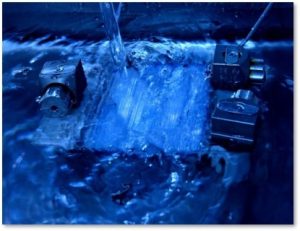
The use of technology in chemistry allows for significant improvements in how we can study and synthesize small molecules. Most notably, the use of continuous flow techniques allows us to perform operations in a safer – and far greener – manner. This technique can be used in a wide breadth of applications, ranging from photo- and electrochemistry for more sustainable production, mechanistic studies to better understand how and why reactions occur, and the synthesis of active pharmaceutical ingredients. Coupled with machine learning, our group uses these approaches to develop better ways of making molecules and accessing previously unexplored areas of chemical synthesis. Critically, these instruments and tools need to be more broadly available, such that the entire chemical community can benefit without having to buy or build things themselves. Akin to cloud computing, we are building a network of automated instruments to perform chemical reactions – this involves writing software, automation/robotics, building new platforms, analytics, and running chemical reactions. We are looking for REU students interested in any of these areas, and those with any experience in coding/robotics are especially welcome to apply.
Synthesis and characterization of photoswitchable inhibitors of potassium channels
PI: Michael Kienzler

Potassium channels are essential proteins for maintaining excitable cells’ membrane potential, perhaps best known for their role in neuron action potential firing. New molecular tools are needed to interrogate the function of potassium channels with high spatiotemporal precision. Our lab is interested in synthesizing small, photoswitchable molecules that can be used to control protein function, and in this project in particular, potassium channel blockers that can be turned “on” and “off” with different wavelengths of light. To achieve this goal, our photoswitch of choice is azobenzene, which can isomerize between cis and trans forms by irradiating the molecule with different wavelengths of light in the Ultraviolet/visible range.
The REU student will synthesize a series of azobenzene-based photoswitchable inhibitors of potassium channels (2-5 steps), purifying (via column chromatography and HPLC) and characterizing (NMR, Mass Spec) their compounds as they go. The photochemical properties of the final compounds will also be determined (UV/vis spectroscopy, NMR).
Synthesis as a Tool in Glycoscience
PI: Mark W. Peczuh

Carbohydrates are indispensable to biological processes such as metabolism, protein folding, and cell-cell interactions. Our group is interested in the design, synthesis, and characterization (conformation, binding) of ring expanded carbohydrates that can interact with natural proteins such as lectins and glycosidases. The preparation of novel ligands of these two broad groups of carbohydrate binding proteins may provide new tools for glycobiology or even future drug leads.
The REU student will synthesize septanose carbohydrate glycosides and glycoconjugates designed for their ability to bind natural lectins and glycosidases. The routes for their synthesis will rely on established procedures, or will be developed by the student. They will be multistep sequences (4-6 steps), where compound purification (chromatography, crystallization) and spectroscopic characterization (NMR, IR, CD, MS) are critical aspects of the research.
Synthesis of molecules emitting chiral light
PI: Gaël Ung

Circularly polarized luminescence (CPL) is the preferential emission of light with a certain circular polarization. Upon non-polarized light absorption, a chiral molecule reaches a preferential excited state which radiatively decays by emitting circularly polarized photons. CPL has emerged as a next-generation light source since the added chiral optical information presents unique opportunities to enhance optical displays, bio-imaging, and security f eatures for banknotes and identification documents. The REU student will synthesize chiral and enantiopure ligands, and study their coordination to lanthanides. The complexes obtained should exhibit CPL. Our laboratory is equipped with two rare CPL spectrometers, including the only NIR-CPL in the Americas. The REU student will be trained in a large variety of synthetic techniques (bench top, Schlenk, glove box), as well as spectroscopic characterizations (NMR, UV-vis, IR, EPR, CPL).
Physical Chemistry
Modeling the Mechanisms of Light Harvesting in a Photosynthetic Antenna Protein
PI: José Gascón
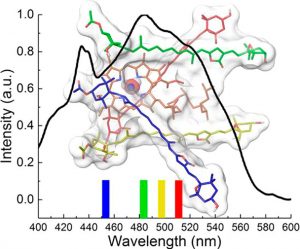
In Prof. Gascón’s group you will carry out multi-scale computer simulations to investigate the first events during light harvesting by carotenoids in a protein antenna. Such levels of molecular detail will allow us to correlate structural properties with spectroscopy analysis. This area of research is of fundamental relevance to socially important topics such as the development of alternative solar energy conversion schemes. To utilize energy from sunlight efficiently for photocatalysis or to produce fuels, we first must learn how nature capture photons especially in the mid-visible regime and transfer the captured energy to reactive sites. You will learn the fundamentals of various levels of theory, from Molecular Mechanics to Quantum Mechanics. If you are interested in chemistry and computation, this experience will challenge you and broaden your understanding of the importance of computational modeling in today’s scientific endeavors.
Hybrid Materials
PI: Jie (Jay) He
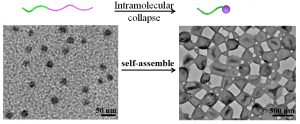
Amphiphilic molecules such as liquids, surfactants, and amphiphilic block copolymers can spontaneously form a wide range of nano- or microstructures such as spherical micelles, cylindrical or worm-like micelles, or bilayer vesicles in selective solvents. Analogues to the self-assembly behaviors of atoms or molecules, the self-assembly of colloidal building blocks,so-called “colloidal molecules”, into various supra-architectures or ordered ensembles provides new opportunities to engineering structures and devices with unique optical, magnetic, or electronic properties. Our group is interested in design and synthesis of colloidal molecules and the use of colloidal molecules as model systems to understand atomic or molecular interactions in self-assembly or crystallization.
The REU student will be trained with various living polymerization techniques (ATRP and RAFT polymerization) and characterization tools (NMR, GPC and electronic microscopes). The student will be exposed to the synthesis and self-assembly of various nanomaterials.
Control of Photo-Generated Charge-Separated States in Donor-Bridge-Acceptor Molecules
PI: Tomoyasu Mani
Research in the Mani Group focuses on photo- and radiation-induced fundamental chemical reactions in the condensed phase. We are particularly interested in controlling electronic excited states, charge and exciton transfer reactions, and spin dynamics in molecules and molecular assemblies. The fundamental understanding of these phenomena will help us improve and develop energy and biomedical technologies.
The REU student will work on the projects that examine the way(s) to control photo-generated charge-separated states. Students will have an opportunity to do either or both organic synthesis and optical (both steady-state and time-resolved) spectroscopy experiments.
Synthesis and application of metal and semiconductor nanoparticles
PI: Jing Zhao

Metal and semiconductor particles at the nanoscale exhibit unique optical properties. One example is size-dependent photoluminescence of semiconductor nanocrystals, which are also known as quantum dots (QDs). QDs have been incorporated into commercial products such as Q-LED TVs. To achieve the desired properties of the nanomaterials, it is critical to control their size and composition. In our lab, we explore new synthetic methods to obtain nanomaterials of varying compositions with uniform morphology. The REU students will gain knowledge in nanomaterials and hands-on experience on nano-synthesis and optical spectroscopy. The student will also have opportunities to apply the nanomaterials in photocatalysis or sensing.
Polymer Chemistry
Polymer Based Vesicles for Therapeutics
PI: Douglas Adamson
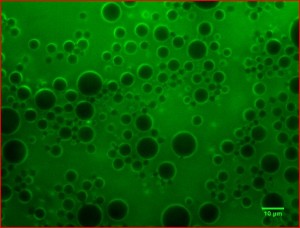
Efficient, yet extremely inexpensive, porous electrodes can be used for applications from super capacitors to the removal of salt from water. The enabling technology for these electrodes is based on our recent discovery that graphite can be exfoliated into individual graphene sheets without the application of harsh chemical treatments or high energy mixing. This process relies on the graphene sheet’s ability to act as a surfactant, and as such, these sheets have been shown to stabilize water-in-oil emulsions. By choosing the appropriate oil, these emulsions can be cured to create strong and electrically conductive porous materials, and preliminary data has shown them to be efficient in the removal of salt from water by a process termed “Capacitive Deionization” or CDI. The REU student for this project will be involved in both the synthesis of new graphene based electrodes as well as the testing and design of new devices. For a more detailed description of the approach, please see our recent publications as listed on our group website.
Use of Persistent Radical Catalysts in Living Polymerization Reactions
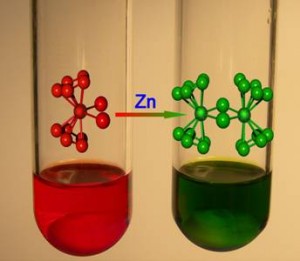
Our group is interested in complex unconventional organic and polymer syntheses, new concepts, reactions and mechanisms. This includes radical polymerizations, polycondensations, liquid crystals, auxetic materials, self assembly and nanostructures. Molecular weight and polydispersity control in living radical polymerization (LRP) is based on the persistent radical effect (PRE). Persistent radicals are not involved in homodimerization reactions or addition to the double bond, and maintain radical concentration at low levels via their reversible end-capping with the growing chain. Various carbon or oxygen centered radicals (nitroxides, addition fragmentation derivatives) and metaloradicals (Cu, Ni, Fe, Ru complexes) are usually employed in LRP. Novel organic and inorganic systems capable of accomplishing LRP are currently being explored. One goal is the design, synthesis and characterization of catalysts capable of dual or multiple mechanism-polymerizations. The REU student will be involved in the synthesis of monomers, catalysts and polymers and in their characterization. He will acquire experience in organic, inorganic and polymer chemistry and will become familiar with instruments such as NMR, GPC, and DSC.
Hybrid Materials
PI: Jie (Jay) He

Amphiphilic molecules such as liquids, surfactants, and amphiphilic block copolymers can spontaneously form a wide range of nano- or microstructures such as spherical micelles, cylindrical or worm-like micelles, or bilayer vesicles in selective solvents. Analogues to the self-assembly behaviors of atoms or molecules, the self-assembly of colloidal building blocks,so-called “colloidal molecules”, into various supra-architectures or ordered ensembles provides new opportunities to engineering structures and devices with unique optical, magnetic, or electronic properties. Our group is interested in design and synthesis of colloidal molecules and the use of colloidal molecules as model systems to understand atomic or molecular interactions in self-assembly or crystallization.
The REU student will be trained with various living polymerization techniques (ATRP and RAFT polymerization) and characterization tools (NMR, GPC and electronic microscopes). The student will be exposed to the synthesis and self-assembly of various nanomaterials.
Shape-Memory Polymers
PI: Rajeswari Kasi
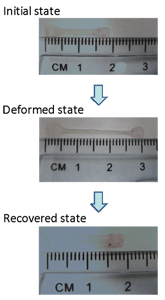
We seek to synthesize, characterize, and, thereby, achieve a fundamental understanding of new biocompatible stimuli-responsive polymers. Development of new synthetic methodologies, modification of existing synthetic routes, multidisciplinary approach to structure-property evaluation, and advanced characterization tools are the overriding factors to rational material design.
Shape memory polymers are a class of responsive polymers that show a reversible temporary shape change with temperature. Upon temperature reduction the initial or permanent shape is achieved once again. We are interested in exploring the influence of architecture and states of matter on shape memory application. The triggering temperature used for these applications could be the glass transition, melting or liquid crystalline transition temperature leading to a multi-variable shape memory approach, Figure 1. Shape memory polymers and hybrid structures can be used in drug delivery, tissue engineering scaffolds, artificial muscles, and actuators.
The undergraduate student researcher will be mentored by a graduate student and the faculty member. The student will learn synthetic polymer chemistry methods and characterization techniques to investigate stimuli-responsive and shape memory properties.
Supramolecular Assembly of Polypeptides into Nanomaterials
PI: Yao Lin
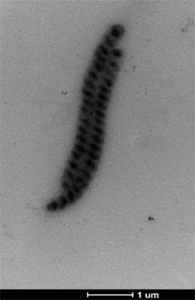
Our research interests are to establish nanomaterial platforms that will bring in interesting biological characteristics (e.g. self assembly and hierarchical assembly) for technology applications. In this specific project, the students will work on the supramolecular polymerization of synthetic polypeptides (functionalized homopolymer, block or random copolymers, or brush-like complex polymers) in solution. The aim is to exploit the design principles and applications of complex macromolecules with intrinsic secondary structures components (e.g. alpha helices). Recently, we have successfully polymerized polypeptide-grafted brush-like polymers into giant superhelical structures (as shown in the transmission electronic microcopy image in the figure). We are now pursuing the general, rational design of polypeptide-based polymers that can be used as macromolecular monomers for supramolecular polymerization into other giant nanostructures. The students will work closely with the PI, the postdoc and the graduate students, and have plenty of opportunities to learn and use state-of-art synthesis and characterization methods available in the Chemistry department and at the Institute of Materials Science.
Nanoscale Controlled Light Emitting Devices by Self-Assembly Techniques
PI: Fotios Papadimitrakopoulos
Papadimitrakopoulos Group website
Implantable biosensors could be a plausible way to continuously monitor blood glucose levels, provided they exhibit long-term stability and means to establish telemetry. However, their potential applications remain largely unexploited due to the negative tissue responses such as biofouling, inflammation, tissue fibrosis, and calcification generated by the implantation of such devices. Other problems such as electrical short, signal drifts and need for continuous calibration can lead to device malfunctioning and eventually failure. Also, one of the chief concerns is the possibility of sensor breakdown because of oxidative degradation of enzyme and other electrode coatings due to excess of hydrogen peroxide present in the immediate vicinity of the sensing electrode. This is a direct result of over-sampling of the glucose in the blood stream. Coating the device by a biocompatible, semipermeable membrane can rectify this situation. Apart from acting as a barrier to permeation of glucose, the membrane would protect the sensor from foreign molecules that cause fouling.
Our group investigated the simplistic, yet versatile approach of layer-by-layer (LBL) self-assembly of assembly of Humic Acids (Has), a naturally occurring biopolymer and Fe3+ cations. Not only did these coatings provide the required degree of glucose permeability, but in vivo results indicated their biocompatibility with reduced tissue fibrosis upon implantation. Furthermore, the conformation and growth characteristics of the HAs/Fe3+ membrane could be tailored by carefully adjusting the pH of the aqueous medium. Apart from the HAs/Fe3+ bilayers, we self-assembled films of HAs/poly (diallyldimethylammonium chloride) (PDDA) and also films of poly (styrene sulfonate) (PSS)/PDDA onto the sensory device. Moreover the diffusion coefficients of glucose through these membrane systems were investigated in order to explain the individual sensor response as it pertains to the microstructure of these outer semipermeable membranes. The hysterisis behavior of these sensors was studied as a function of permeability of the outer membrane. It was concluded that the microstructure of these coatings govern the permeability of glucose and correspondingly, the sensitivity, longevity and hysterisis of the sensors.
We plan to extend this outer membrane research to a more biocompatible polyelectrolytes like poly saccharides and proteins, which we aniticipate to finish within one summer.
The incoming REU student will be exposed to a variety of techniques including electrochemical sensor fabrication, electro-analytical techniques, ellipsometry, enzyme immobilization, electropolymerization of conducting polymers, layer by layer assembly, in vitro and in vivo testing of electrochemical sensors as well diffusional based theoretical modeling of electrochemical sensors.